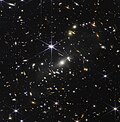| Deep Sky | |
|---|---|
 Poster of the film featuring the Pillars of Creation | |
| Directed by | Nathaniel Kahn |
| Produced by | Sandra Evers-Manly Bonnie Hlinomaz Charles Mattias 'Matt' Mountain Gerry Ohrstrom John Turner |
| Cinematography | Michael McClare Robert Richman |
| Edited by | Brian Johnson Jay Keuper |
| Distributed by | Crazy Boat Pictures Limited [1] |
Release date |
|
Running time | 40 minutes |
| Country | United States |
| Language | English |
| Box office | $112,320 [2] |
Deep Sky is a 2023 American documentary film directed by Nathaniel Kahn. [3] Originally released on October 20, 2023 for IMAX, [4] [5] Deep Sky is narrated by Michelle Williams telling the story about the production of the James Webb Space Telescope and its impact on the technological improvements it made upon the Hubble Space Telescope. [6]
Contents
Although it was filmed in 2023, the documentary did not receive a wide release until April 19, 2024 [7] in commemoration with Earth Day. [8]

